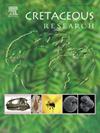Taxonomic reassessment of the genera Blittersdorffia and Diegopteryx (Neuroptera, Myrmeleontidae) from the Lower Cretaceous Crato Formation with the description of three new species
IF 1.7
3区 地球科学
Q1 GEOLOGY
引用次数: 0
Abstract
The Crato Formation in Brazil harbors over half of the world's known fossil diversity of Myrmeleontidae. However, many type specimens of taxa described from this formation were previously inaccessible. With the recent rediscovery of two Brazilian collections and the acquisition of several newly discovered, well-preserved specimens, we have revised two controversial Myrmeleontidae genera: Diegopteryx Martins-Neto & Rodrigues and Blittersdorffia Martins-Neto & Vulcano. In this study, we describe two new species of Diegopteryx and one new species of Blittersdorffia. Additionally, Blittersdorffia pulcherrima has been reassigned to Diegopteryx and D. raptoria is synonymized with B. pulcherrima. We provide updated diagnoses for both genera and an identification key for the species. We also examine the implications of these new findings for understanding the evolutionary relationships of these genera within fossil Myrmeleontidae.
下白垩世克拉托组大翅鸟属和大翅鸟属的分类重新评估及3新种描述
巴西的克拉托组拥有世界上已知的一半以上的myremeleontidae化石多样性。然而,从这个地层描述的许多分类群的模式标本以前是无法获得的。随着最近在巴西重新发现了两组标本,并获得了一些新发现的保存完好的标本,我们修订了两个有争议的myremelontidae属:罗德里格斯和布里特斯·多菲娅·马丁斯-内托&;火山。在本研究中,我们描述了两个新种的翅祖鸟和一个新种的Blittersdorffia。此外,Blittersdorffia pulcherrima已被重新分配给Diegopteryx, D. raptoria与B. pulcherrima同义。我们提供了更新的诊断为两个属和识别关键的物种。我们还研究了这些新发现对理解这些属在化石Myrmeleontidae中的进化关系的意义。
本文章由计算机程序翻译,如有差异,请以英文原文为准。
求助全文
约1分钟内获得全文
求助全文
来源期刊

Cretaceous Research
地学-地质学
CiteScore
4.10
自引率
19.00%
发文量
235
审稿时长
12 weeks
期刊介绍:
Cretaceous Research provides a forum for the rapid publication of research on all aspects of the Cretaceous Period, including its boundaries with the Jurassic and Palaeogene. Authoritative papers reporting detailed investigations of Cretaceous stratigraphy and palaeontology, studies of regional geology, and reviews of recently published books are complemented by short communications of significant new findings.
Papers submitted to Cretaceous Research should place the research in a broad context, with emphasis placed towards our better understanding of the Cretaceous, that are therefore of interest to the diverse, international readership of the journal. Full length papers that focus solely on a local theme or area will not be accepted for publication; authors of short communications are encouraged to discuss how their findings are of relevance to the Cretaceous on a broad scale.
Research Areas include:
• Regional geology
• Stratigraphy and palaeontology
• Palaeobiology
• Palaeobiogeography
• Palaeoceanography
• Palaeoclimatology
• Evolutionary Palaeoecology
• Geochronology
• Global events.
 求助内容:
求助内容: 应助结果提醒方式:
应助结果提醒方式:


